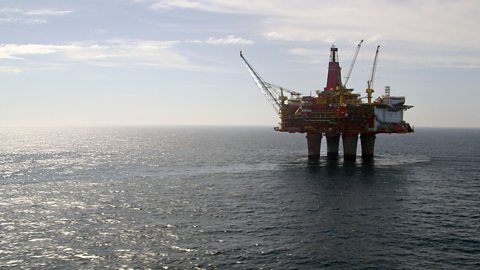What happens if we run out of oil?
By
It took hundreds of millions of years to create the world’s oil reserves.
It took less than a century before oil became the commodity on which world power turned.
And it was little more than a century before fears were raised that we would run out of oil.
Fifty years further on, it’s less clear than ever how much is left. That’s because technological advance has confounded those who feared there were tight constraints on what could be drilled.

The rich rewards from oil have fuelled initiative and invention. As Professor Iain Stewart explains in , this wasn't just a passion for scientific and engineering endeavour.
It was economic, political and strategic military calculation that drove the UK and the US to find ways of becoming less dependent on supplies from the Middle East.
Having done so, they started to innovate. When the pioneers of the North Sea first found oil, they had little expectation that they could recover more than about a third of what they found.
But the rock formations that make up these fields have yielded far more than expected, maintaining the industry far longer. The next giant discovery to be developed in the North Sea – the 2-billion-barrel Johan Sverdrup field near Stavanger in Norway – has a target of 70% recovery.
With a lifespan stretching beyond the 2050s and into the third century of the oil industry, it may be possible to extract even more than that. Indeed, if past decades of technological advance are any guide, it’s very likely that more can be recovered.
That’s why the debate about Peak Oil – the point at which prices head sharply upwards because oil explorers fail to find replacement reserves – is seen as less of a threat than even ten years ago.

How the discovery of oil changed the North Sea
A look at the paranoia that surrounded the discoveries.
New techniques; new locations
Instead of needing many and mobile platforms for vertical drilling, fields can be drilled horizontally. is a developing technique that involves the use of chemicals to flush out more from reservoirs as they deplete.
We鈥檙e still learning how to handle the technical challenges at the new frontiers of this industry.
There are attempts to commercialise carbon capture, meaning that treated emissions could be pumped into old oil wells.
The main reason would be to remove emissions from the atmosphere, but the process could also be used to displace more oil from porous rock.
With improved drilling techniques, oil fields can be found much deeper underground than before. And with clever vessel handling and positioning, offshore exploration can go into ever deeper and wilder water.
In the UK, that's taking the frontier west of Shetland, where the giant Laggan-Tormore gas and oil field will come on-stream later this year.
America's leading geological institute reckons that one of the world's ten biggest oil basins could be between Greenland and Canada. That adds icebergs and the deep freeze of winter to the dangers.
The few attempts at drilling there have not found anything significant. And at enormous cost for exploratory wells, Greenland waters are being left to the narwhals while the price remains at current lower levels.
However, the ability to operate in very cold conditions, or by putting equipment on the seabed has opened up the wider Arctic potential. It has also opened up geo-political rivalries over which countries own it.
We’re still learning how to handle the technical challenges at the new frontiers of this industry, where there are exceptionally high temperatures and pressure, and where heavy viscous oil is unusually hard to extract.
In Canada’s Alberta province, new methods are being used to extract oil from tar sands. The US boom in fracking has opened up new possibilities for extracting gas and oil from shale rock, notably in Texas and the Dakotas.

That’s not as new as it might seem, though. James ‘Paraffin’ Young pioneered the extraction of oil from shale rock in West Lothian, moving there in 1852. The 'bings' of mine waste are still a feature on the Forth Valley horizon.
We’re now at the early stages of seeing what energy reserves could be unlocked by re-opening coal seams for controlled burn underground, extracting coalbed methane, and by fracking shale.
Beyond America, fracking prospects look strong in China, Poland and France – if there is the political will to let the drillers get to work.
That doubt is because the industry’s methods are proving controversial. The methods used and the impact on geology and on underground water courses have provoked opposition.
Climate change and the future
And the burning of oil – as with gas and coal – has been targeted as the main source of climate change.
China and India are among those facing major problems with urban air pollution
So the future of the industry may not depend so much on how much supply can be unlocked to meet fast-growing demand from emerging economies.
It may have more to do with the political will to choke off demand and cut back emissions.
The attempts to find and implement international agreement on that have not been a notable success. From Kyoto to Copenhagen, grand government gatherings have sought to find common ground, and that circus moves on later this year to Paris.
What will be different this time? Well, the debate over whether climate change is for real, and why it might be happening, has not gone away. The doubting voices from Washington’s Capitol Hill don't help in reaching deals.
But pushing for more action, environmental campaigners are increasing pressure on banks and moreso on investors to withdraw from oil and gas projects.
Meanwhile, the klondyke rush to grow economies in Asia and South America has slowed. And for some, the environmental cost of the new prosperity has caught up.
China and India are among those facing major problems with urban air pollution. And their city roads have become so congested that the growth in private, oil-burning transport may, literally, be choked off.
Prices and policy
Of course, price has a role to play in this demand and supply. Fracked gas has become so cheap in the US that it undercut oil and coal in the USA, and power generation has shifted to gas, as the fuel with lower emissions.
Energy-intensive industries have been attracted to the USA, even bringing back some of those which had previously offshored jobs to countries where labour was much cheaper.
Regulation has a role to play too. In the US and the European Union, governments have passed on their international obligations to cut climate change by requiring the design of more efficient cars, commercial transport and aviation.
Policy has pushed car manufacturers towards more hybrid and electric cars, and the use of biofuels.
Governments have also ensured renewable energy is subsidised by customers, to replace the retiring power stations which have long emitted CO2.
With rising pollution in big Asian cities, some similar measures are being taken by governments there. The low oil price this year gives them an opportunity to remove fuel subsidies. That ought to limit demand.
So where there used to be a strong link between economic growth and the increasing demand for oil, that link is being broken.
As countries grow their economies, service industries take a larger share than manufacturing. That, too, weakens the growth in demand for oil.
And instead of the 20th century imperative to find new, diverse sources of oil, the imperative now is to use oil more efficiently and to find new, different renewable alternatives to it.
Extraordinary achievements by innovative engineers and scientists have relaxed the constraints on the supply of oil. The upward pressure on the demand for it is also cooling.
Perhaps we won’t run out of oil, but instead learn to need it less.
Video from Planet Oil
More clips from the programme

What it’s like to take a bath in oil

